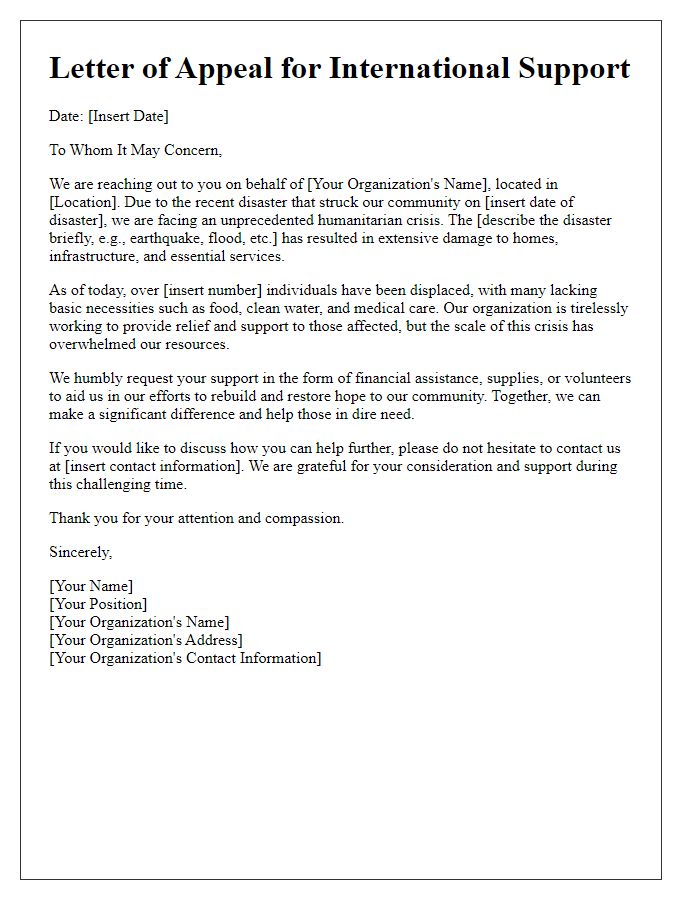Are you passionate about making a difference in the world? Writing a compelling letter for an international aid donation is a powerful way to connect with potential supporters and convey the urgent need for assistance. In this article, we'll provide you with effective tips and a handy template to craft a persuasive message that captures hearts and encourages generosity. Ready to start making an impact? Let's dive in!

Clear Introduction
The urgent need for humanitarian assistance has escalated in regions affected by natural disasters, such as the recent earthquakes in Turkey and Syria, where thousands of families remain displaced. Organizations like the Red Cross and Doctors Without Borders are mobilizing resources to provide essential aid, including food, medical care, and shelter. Your support can significantly impact these communities struggling to recover from devastating events. Donations can supply critical supplies, offering hope and recovery to those in need during this challenging time.
Compelling Story
The devastating earthquake in Turkey on February 6, 2023, measuring 7.8 on the Richter scale, left millions homeless and in dire need of assistance. Rescue efforts in cities like Kahramanmaras and Gaziantep faced overwhelming challenges due to the sheer scale of destruction, with entire neighborhoods reduced to rubble. Over 58,000 lives were tragically lost, and countless families have been displaced, struggling to find basic necessities such as food, clean water, and shelter. Local organizations, alongside international aid agencies, are working tirelessly to provide emergency relief and rebuild communities. Your generous contribution can provide immediate aid, such as medical supplies and food packages, helping to restore hope and resilience in the face of unimaginable loss.
Specific Call to Action
International aid organizations often face significant funding challenges to support crucial humanitarian programs worldwide. A compelling donation request should outline specific needs, like funding for clean water projects in regions affected by drought, which can impact community health and economic stability. For example, $25 can provide access to clean water for a family of four for an entire month. The urgent need for medical supplies in conflict zones, where thousands of vulnerable individuals suffer, highlights a critical area requiring immediate financial support. Cooperation from individuals and businesses can help deliver essential supplies, such as hygiene kits or food assistance, directly to those in need. Every contribution can have a profound impact, fostering resilience and hope in the most affected areas.
Detailed Donation Use
International humanitarian efforts often rely on donations to support various projects and initiatives aimed at alleviating suffering and building a sustainable future. For example, donations can be allocated to disaster relief efforts following natural calamities such as earthquakes, hurricanes, or floods that impact vulnerable populations. Funds may cover immediate needs like food, clean water, and medical supplies, as well as long-term recovery projects focused on rebuilding infrastructure in affected areas, such as schools and hospitals. Additionally, contributions might support education programs, providing learning materials and scholarships for children in impoverished regions, or health initiatives aimed at combating diseases like malaria or HIV/AIDS, ensuring communities have access to essential medical care. Engaging in these activities can create lasting change, transforming lives in locations such as Haiti, Yemen, or Syria, where communities are in dire need of assistance.
Contact Information
International humanitarian organizations frequently rely on donations to support their efforts in crisis-stricken areas, such as war-torn countries or regions affected by natural disasters. Donations enable various initiatives, including food distribution, medical assistance, and shelter provision. For example, the United Nations Children's Fund (UNICEF) and the International Red Cross play vital roles in delivering relief to millions. Organizations often include a contact information section in their donation request letters to facilitate communication with potential donors. This section typically consists of details like organization name, email address, phone number, and a mailing address, ensuring transparency and easy outreach for inquiries related to donation processes or project impacts.
Letter Template For International Aid Donation Request Samples
Letter template of appeal for international support for disaster relief.

Letter template of solicitation for global assistance in crisis recovery.

Letter template of inquiry for foreign aid contributions for community development.

Letter template of proposal for overseas donations to support vulnerable populations.

Letter template of appeal for charitable contributions to enhance global health initiatives.

Letter template of request for aid partnerships in international education programs.

Letter template of solicitation for funds to provide essential supplies in developing regions.

Letter template of request for collaborative efforts in sustainable development projects.






Comments